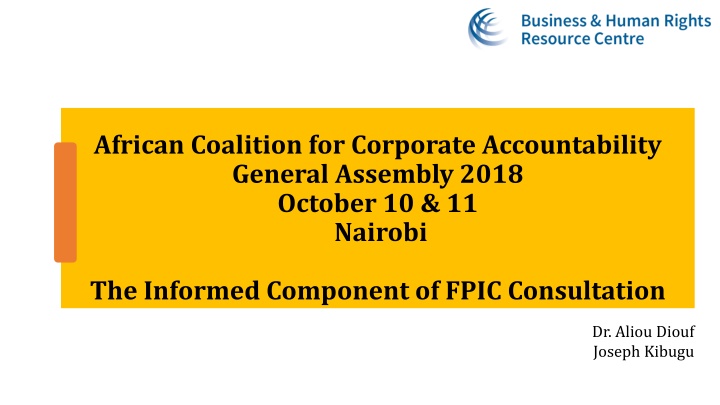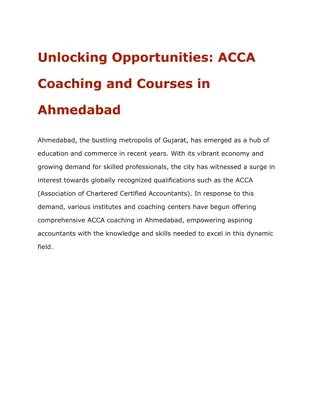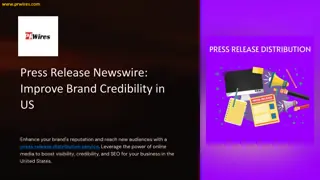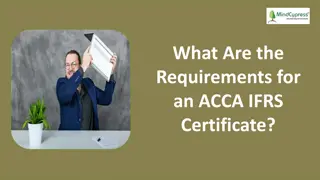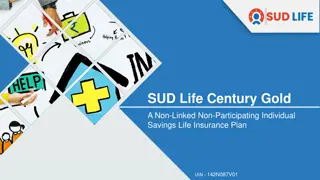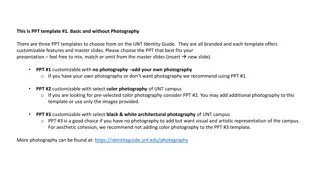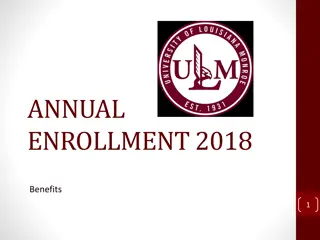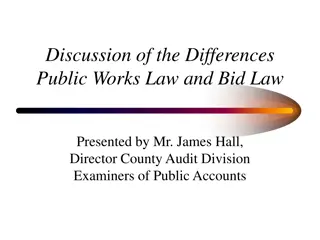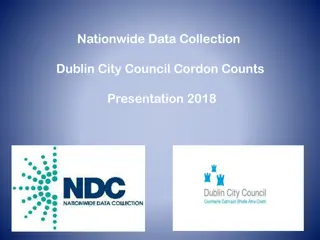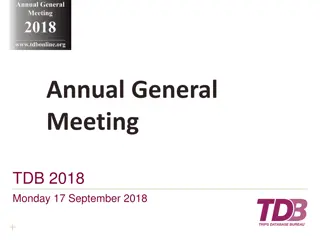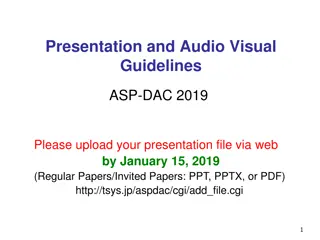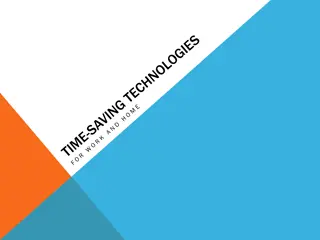Enhancing Corporate Accountability and Transparency for Sustainable Development
The African Coalition for Corporate Accountability aims to strengthen corporate accountability, build transparency, and track human rights policies of over 7500 companies worldwide. They engage with companies and governments to promote public information sharing and address human rights concerns. Through various tools and strategies, they empower advocates and amplify the voices of vulnerable communities. Their efforts contribute to ensuring Free, Prior, and Informed Consent (FPIC) by providing necessary information for informed decision-making.
Download Presentation

Please find below an Image/Link to download the presentation.
The content on the website is provided AS IS for your information and personal use only. It may not be sold, licensed, or shared on other websites without obtaining consent from the author.If you encounter any issues during the download, it is possible that the publisher has removed the file from their server.
You are allowed to download the files provided on this website for personal or commercial use, subject to the condition that they are used lawfully. All files are the property of their respective owners.
The content on the website is provided AS IS for your information and personal use only. It may not be sold, licensed, or shared on other websites without obtaining consent from the author.
E N D
Presentation Transcript
African Coalition for Corporate Accountability General Assembly 2018 October 10 & 11 Nairobi The Informed Component of FPIC Consultation Dr. Aliou Diouf Joseph Kibugu
Objectives of the session I. II. Demonstrate the Resource Centre s strategies and tools for transparency & accountability of companies III. Obtain feedback on new tools we are developing & our priorities for the year IV. Identify opportunities for further engagement Introduce the Resource Centre
Aims We strengthen corporate accountability We build corporate transparency We track the human rights policy and performance of over 7500 companies in over 180 countries, making information publicly available. We engage with companies and governments to urge them to share information publicly. We help communities and NGOs get companies to address human rights concerns, and provide companies an opportunity to present their response in full. We take up alleged abuse quickly and directly with companies. We ve made over 2400 approaches to companies asking them to respond to specific human rights allegations. Our global response rate has grown over 70%. We empower advocates We amplify the voices of the vulnerable, and human rights advocates in civil society, media, companies and governments.
What does this have to do with FPIC? We help contribute to the I in FPIC Communities cannot give Free, Prior, and Informed Consent without access to the right type of information to be adequately informed. For example, communities may want to know the company s track record on land issues or livelihoods. They may want to know if the company has a history of conducting adequate human rights due diligence prior to making an investment. Or they may want to know if the company is facing lawsuits on human rights grounds in other jurisdictions.
BHRRCs Response to Information Gap In the course of our work with grassroots NGOs, we identified gaps in accessing information on various human rights aspects of companies and developed various tools: o Company Response Mechanism o Documentation Checklist o Companies Benchmarks and Ranking o Deep dives/specialized tools to analyse human rights in high risk countries and sectors e.g. Ugandan oil sector, banking in southern Africa mining sector, etc.
Le Mcanisme de rponse des entreprises Company Response Process Historique et r le du M canisme de r ponse des entreprises: Date de cr ation: 2005; + 1,2 millions d approches; Taux de r ponses global des entreprises: 70%; R le du M canisme: permettre aux entreprises de r pondre publiquement aux all gations d abus les concernant. Caract ristiques de la proc dure: impartialit , droit de r ponse des entreprises, seuls les abus s rieux et pr cis sont concern s. Le M canisme n est actionn que si l entreprise n a pas encore r pondu publiquement aux all gations. Utilit de la proc dure: peut favoriser le dialogue entre l entreprise et les communaut s et parfois m me aboutir des solutions aux probl mes pos s.
Le mcanisme de rponse des entreprises Soci t civile Entreprise Site internet +2 millions de visites +17,000 abonn s nos Actualit s Hebdomadaires Le Centre La r ponse d une entreprise ne m ne pas toujours une action mais elle indique tout de m me sa volont de s engager publiquement en ce qui concerne les inqui tudes soulev es par la soci t civile. Elle fournit aussi une d claration publique opposable l entreprise.
Le mcanisme de rponse des entreprises La lettre d invitation r pondre Il s agit d un message lectronique adress e l entreprise. Il comprend: une br ve introduction qui pr cise la nature des all gations et notre volont de les porter l attention internationale pr sentation du Centre si c est la premi re fois titre du document contenant les all gations et ses r f rences d lai pour nous envoyer la r ponse (environ 2 semaines en g n ral). taux de r ponse nos invitations r pondre (70%) Les types de r ponses des entreprises Les r ponses positives qui peuvent tre compl tes et satisfaisantes ou laconiques et insuffisantes
Le mcanisme de rponse des entreprises Suivi des r ponses Pour les r ponses positives qui sont compl tes et satisfaisantes: Affichage sur notre site et publication dans les Actualit s Hebdomadaires. Pour les r ponses positives qui sont laconiques et insuffisantes leur suivi peut donner lieu : une r plique de la part de l auteur du document contenant les all gations; une r ponse de l entreprise cette r plique; Dans certains cas, elles peuvent aussi aboutir : un dialogue fructueux entre l auteur du document et l entreprise ou un blocage, chaque partie maintenant sa position. Pour les non r ponses: Les non r ponses peuvent donner lieu un suivi approfondi de notre part.
Le mcanisme de rponse des entreprises Seuls les secteurs ayant en tout plus de 50 incidences ont t retenus. Par incidences , il convient d entendre le nombre de r ponses et de non r ponses re ues des entreprises contact es. Sur le sch ma, on voit que l agriculture a le taux de r ponse le plus lev , suivi par le secteur des produits de grande consommation alors que les ressources naturelles et le secteur des technologies ne viennent qu en 4eet 5eposition.
Le mcanisme de rponse des entreprises Region of alleged abuse Response rate Il montre que l Afrique a un taux de r ponses tr s lev , ce qui s explique par le nombre important de r ponses que nous recevons des entreprises op rant en Afrique du Sud. il suffit d enlever l Afrique du Sud pour que a change. D ailleurs, on le voit tr s bien dans le tableau suivant o l Afrique du Sud affiche un taux de r ponse de 88.68% alors que le reste de l Afrique n affiche qu un taux de 63.64%. Africa Americas No. America 78,17% 77,00% 71,78% Asia & Pacific 69,41% NSW Europe 69,23% Eastern Europe & Central Asia Middle East & No. Africa 61,11% 53,25%
Le mcanisme de rponse des entreprises Exercice R fl chissez sur 2 ou 3 exemples pour lesquels il serait utile de demander l entreprise ou les entreprises concern e(s) de vous fournir une r ponse. Pr cisez l endroit ou le projet, pr cisez galement en une phrase les violations all gu es. Enfin, pr cisez aussi le nom ou les noms des entreprises que vous devez approcher sur la situation. Think about 2-3 examples of cases you can think of where it would be be useful to seek a company response to an allegation of abuse. Write down the location or project, one sentence on the allegation of abuse, and the name of the company or companies you could approach about the situation.
2. La documentation des violations des droits de lhomme impliquant des entreprises/ Documentation Checklist Outil d velopp par le Centre et le R seau DESC But de cet outil: Aider les communaut s locales et les ONG qui les soutiennent mieux faire face aux impacts des entreprises Documenter les all gations d abus Attirer l'attention sur la situation des communaut s impact es Leur permettre de construire leur capacit de plaidoyer et leurs alliances Les preuves r colt es peuvent aider dans le plaidoyer aupr s de l entreprise concern e et/ou des autorit s publiques Peut aider dans la constitution d un dossier contre l entreprise pour des actions plus pouss es
2. La documentation des violations des droits de lhomme impliquant des entreprises/ Documentation Checklist https://www.business-humanrights.org/en/checklist-documenting-corporate-human-rights-impacts
2. La documentation des violations des droits de lhomme impliquant des entreprises/ Documentation Checklist Exercise Parmi les cas que vous avez identifi s un peu plus haut, choisissez-en un. Pouvez-vous r pondre aux questions contenues dans la liste de documentation d abus pour ce cas ? Si non, quelles sont les informations suppl mentaires dont vous avez besoin pour ce cas et comment pouvez proc der pour les trouver ? Pick one of the cases you identified earlier. Can you answer the questions in the documentation checklist about that case? If not, what additional information do you need about the case, and how could you go about finding it?
Corporate Human Rights Benchmark www.corporatebenchmark.org The Corporate Human Rights Benchmark is a unique collaboration led by investors & civil society organisations dedicated to creating and publishing a public benchmark on corporate human rights performance
Corporate Human Rights Benchmark Just under 100 of the largest publicly traded companies in the world On 100 human rights indicators across 6 Measurement Themes Using international standards the UN Guiding Principles on Business and Human Rights +
Corporate Human Rights Benchmark Significant indicators evaluated by the Benchmark: Commitment to respect human rights Industry-relevant rights Commitment to remedy Internal communication about company s commitment to human rights Engagement with potentially affected stakeholders Due diligence Public reporting Human Rights Defenders Responsibility and resources for day- day human rights operations Monitoring and corrective actions Land rights Living wage Sustainability
Corporate Human Rights Benchmark Key takeaways Poor scores overall average of 2 out of 10 Significant interest from companies and investors in these results 2018 iteration to include IT companies will be released next month
Uganda Investment Map Responds to an expressed need for information on the companies that are operating in the oil sector Covers upstream and downstream exploration, production, transport, financing, refinery, waste disposal, pipeline, and Central Processing Facility Seeks to be a resource for civil society organizations supporting communities impacted by oil-related businesses to hold them to account Based on companies responses to our survey on their human rights policies, and on publicly-available information
Uganda Investment Map https://www.business-humanrights.org/en/oil- in-uganda
Southern Africa Mines Banking Survey Are banks promoting respect for human rights in Southern Africa Mines? Traces allegations of human rights abuses at specific Southern Africa mines to mining companies to the banks that finance them. Allegations include displacement; lack of consultation and failure to honour agreements; contamination of air, soil, and water; loss of livelihood; labour violations including unpaid wages; health and safety hazards; and complicity in state-sponsored violence toward miners including rape and murder. 30 banks, investment firms, or mining companies with investment branches surveyed on the human rights issues they identify when they consider financing
Exercise Think about the case example you have been working on. In small groups of 2-3, brainstorm what information about companies you would like to have access to in order to effectively engage with them. Which of the following would you find useful, or what other information would you seek, and why? Company human rights policies Past company performance Information about subsidiaries, partners, and other related companies Information about where the company is headquartered or is listed Company operations including map Publicly-available contracts Company support for access to information/transparency initiatives Other (please specify)
How to get engaged Reach out to use for a company response using our Company Response Mechanism Download the Documentation Checklist and support communities with documentation Ask us to add Company Pages not currently on our site Become a beta user or help us develop our new company dashboards Partner with us on specific projects. Some of our upcoming priorities including looking at the minerals used the production of renewable energy technology, and the human rights impacts of renewable energy companies themselves
Wrap up & Evaluation Objectives of the session: I. Introduce the Resource Centre II. Demonstrate the Resource Centre s strategies and tools for transparency & accountability of companies III. Obtain feedback on new tools we are developing & our priorities for the year IV. Identify opportunities for further engagement
Thank you! www.business-humanrights.org Kibugu@business-humanrights.org Diouf@business-humanrights.org Sign up for our free Weekly Updates: http://business-humanrights.org/en/weekly-update-sign-up Souscrire notre newsletter https://www.business-humanrights.org/fr/souscrire-%C3%A0-notre- newsletter
